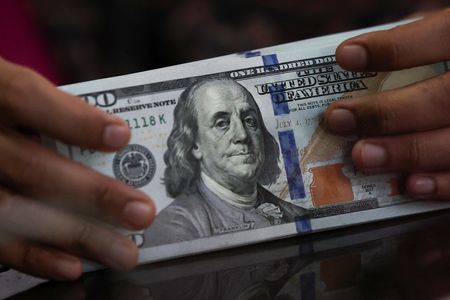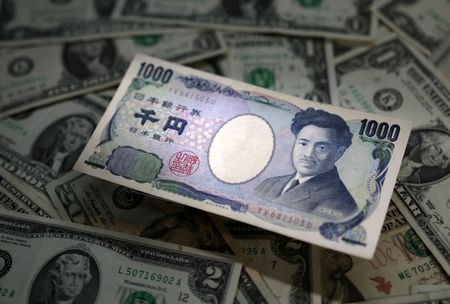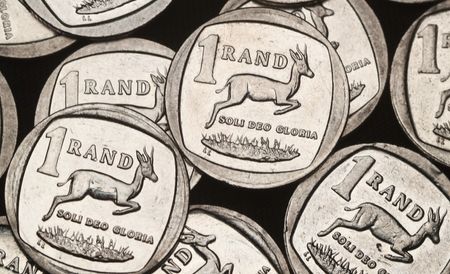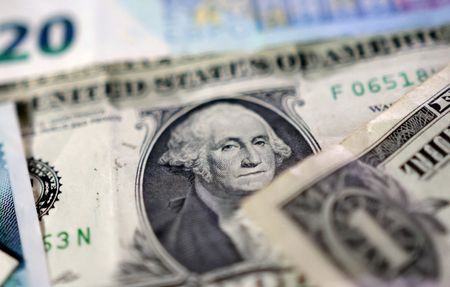By Saqib Iqbal Ahmed
NEW YORK (Reuters) -The dollar eased on Friday as a data-heavy week wound down, keeping the case for a September Federal Reserve interest rate cut intact, while traders awaited talks in Alaska between Donald Trump and Vladimir Putin regarding Ukraine.
The dollar, which had jumped on Thursday as data showed U.S. producer prices increased more than expected in July, gave up most of those gains on Friday, and was set to finish the week 0.5% lower against a basket of currencies.
“The PPI figure yesterday was a shock, but there is still little concrete evidence for a tariff-driven spike in inflation,” Kyle Chapman, forex markets analyst at Ballinger & Co in London, said.
“With markets staying firm on their bets for a September cut and the focus now shifting to Alaska, the dollar is handing back its gains this morning,” Chapman added.
Money markets reflect a 93% chance of a 25-basis-point Fed rate cut in September, according to CME FedWatch.
A Fed interest rate cut in September, the first this year, followed perhaps by another before year-end, remains the base forecast for most economists polled by Reuters amid rising concerns about the health of the world’s biggest economy.
Chicago Federal Reserve Bank President Austan Goolsbee on Friday said the latest reports this week showing a rise in services inflation are a source of “unease” given what he sees as the stagflationary impulse from tariffs on the economy.
On Friday, investors were also watching to see if the Trump-Putin summit made any progress towards a ceasefire in Ukraine.
“While anything could happen at the meeting between Trump and Putin, I think expectations are low for progress towards a lasting ceasefire and that tilts the risks towards a softer dollar if the market is pleasantly surprised,” Ballinger’s Chapman said.
Most analysts expect Europe’s single currency to benefit from any ceasefire deal in Ukraine. The euro was 0.5% higher at $1.1708 versus the dollar.
The dollar found little support on Friday from data that showed U.S. import prices rebounded in July, boosted by higher costs for consumer goods.
Separately, U.S. retail sales increased solidly in July, boosted by strong demand for motor vehicles as well as promotions by Amazon and Walmart.
Markets also await next week’s Jackson Hole symposium for clues on the Fed’s next move. Signs of weakness in the U.S. labour market combined with any inflation from trade tariffs could present a dilemma for the Fed’s rate cut trajectory.
“Recession risks remain low, but I think it’s wise for the Fed to shift to a more neutral stance and cut rates in coming meetings,” Jeffrey Roach, chief economist for LPL Financial, said in a note.
Against the yen, the dollar was 0.5% lower at 146.975 yen, following the release of surprisingly strong Japanese growth data, which showed export volumes held up well against new U.S. tariffs.
U.S. Treasury Secretary Scott Bessent’s remarks earlier this week that the Bank of Japan could be “behind the curve” in dealing with the risk of inflation proved to be another tailwind for the yen this week.
Sterling rose against a weakening dollar on Friday and was set to end the week higher after upbeat economic data and a hawkish rate cut by the Bank of England. The pound was last up 0.3% to $1.35705, taking its gains for the week to 0.9%.
Elsewhere, bitcoin and ether rose after dropping about 4% each on Thursday. Bitcoin had at one point touched a record high on Thursday as increasing expectations for easier monetary policy from the Fed added to optimism stemming from a pro-crypto regulatory environment in Washington.
(Reporting by Saqib Iqbal Ahmed; Additional reporting by Stefano Rebaudo; Editing by Shri Navaratnam, Kim Coghill, Christina Fincher, Joe Bavier and Andrew Heavens)










